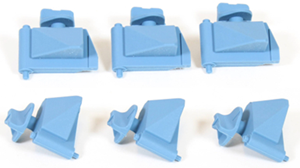Not Your Grandpa’s Plastics Processing Operation
New materials and machinery offer processors the means to run their businesses more efficiently and more inline with the circular economy. But you have to say yes.

If you’ve been following recent developments in both materials and machinery, perhaps you have come to the same conclusion I have: the North American plastics processing industry will have access to new ways of doing things, and how quickly they embrace them will go a long way toward determining its (your) future.
Yes, this is a conservative industry. It takes a long time for North American processors to adapt to change. That’s not meant to be a criticism, because even with all of the M&A activity over the past 20 or so years this is still an industry with a healthy share of small- to medium-sized companies. And truth be told, many of these types of companies tend to be set in their ways and don’t get excited about change.
Maybe 50 years ago, when robotics began to get a foothold in injection molding, Plastics Hall of Famer and Husky founder Robert Schad advised his customer to “automate or die.” Today, maybe “adapt or die” is more apropos.
All of this came rushing into my mind as I reviewed all of the new technology that will be displayed at this month’s NPE2024, or when I spoke one-on-one with companies bringing this technology to the industry. Time and again I have remarked that technology advances in this business have been more evolutionary than revolutionary. But that’s starting to change. Let me give a few specifics:
- Additive Manufacturing (AM): In plastics, we more commonly refer to this as 3D printing. This is not about prototyping. This is about making fully functional production parts. In our space, this technology is being used to fashion mold components in days that typically would take weeks. Even in extrusion, I know of one processor using AM to fashion sizing tools for profiles. Of course, AM technology can also be used to produce polymer parts in short- to medium-sized runs.
- Sustainable Materials: It’s here now, it’s not going away and there is more to come. If you are not yet making products using either recycled content materials, bioresins and more, most certainly your customers will be asking you to in short order. This is especially the case if your products fall into the single-use category. Brand owners and OEMs are demanding it. And, by the way, products formed using these new materials have to perform to the same levels as those made from traditional materials.
- Smart Machines & Automation: Sensor technology and artificial intelligence are changing what machines of all types can do. The idea is to get knob turning and button pushing out of the process … and that’s a good thing, because processors have fewer and fewer people nowadays to turn knobs and push buttons. So, auxiliary equipment of all types as well as primary processing machines are being engineered to do tasks formerly handled by operators on their own, making for process steps that are more efficient, cost effective and repeatable.
Plastics Technology magazine is part of Gardner Business Media. Gardner was founded in 1928 with the launch of Modern Machine Shop magazine, still the leading publication in metalworking. At the time of its launch, Don C. Gardner, founder of the company that bears his name, said this: “Time passes, conditions change, the world progresses — and those who are found keeping pace with the new order of things are those who are young enough in mind and spirit to recognize the value of the new and to make themselves a part of it.”
It's time for you to join.
Related Content
Business Slowing? There's Still Plenty of Stuff to Do
There are things you may have put off when you were occupied with shipping parts to customers. Maybe it’s time to put some of them on the front burner.
Read MoreBidding So Long — But Not Goodbye — To Plastics Icon Matt Naitove
After 51 years of contributing content, plastics industry stalwart will take a step back.
Read MoreSix Years in the Waiting, PLASTICS Igniting a ‘Spark’ at NPE
New features of NPE2024 aim to “bring the whole plastics ecosystem together to innovate, collaborate and share findings.”
Read MoreAttention Molders: Time to Get Serious About Sustainability
If you’re not looking at ways to make your injection molding operation more sustainable, perhaps you’d better get started.
Read MoreRead Next
See Recyclers Close the Loop on Trade Show Production Scrap at NPE2024
A collaboration between show organizer PLASTICS, recycler CPR and size reduction experts WEIMA and Conair recovered and recycled all production scrap at NPE2024.
Read MoreBeyond Prototypes: 8 Ways the Plastics Industry Is Using 3D Printing
Plastics processors are finding applications for 3D printing around the plant and across the supply chain. Here are 8 examples to look for at NPE2024.
Read MorePeople 4.0 – How to Get Buy-In from Your Staff for Industry 4.0 Systems
Implementing a production monitoring system as the foundation of a ‘smart factory’ is about integrating people with new technology as much as it is about integrating machines and computers. Here are tips from a company that has gone through the process.
Read More






















